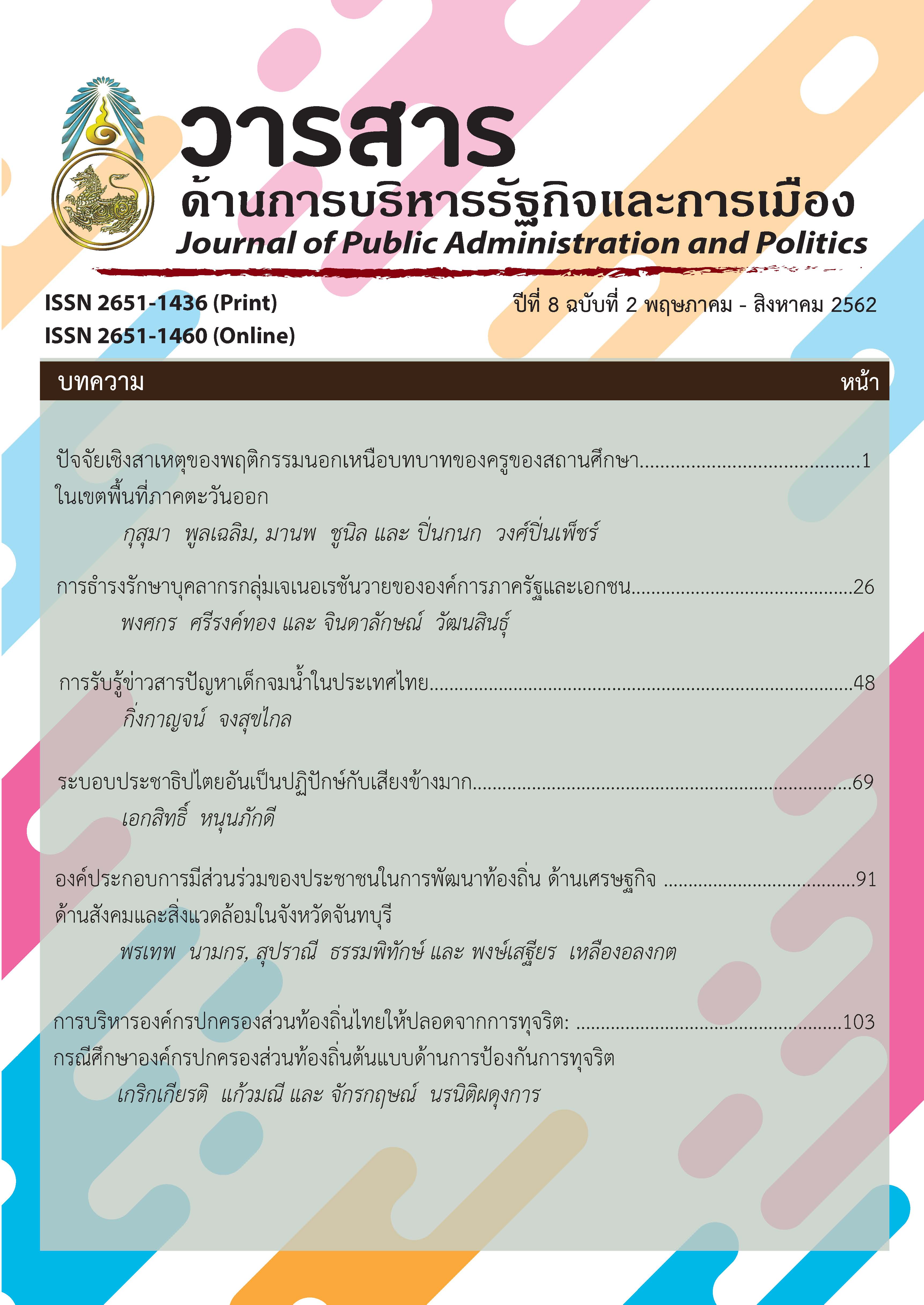การธำรงรักษาบุคลากรกลุ่มเจเนอเรชันวายขององค์การภาครัฐและเอกชน
Main Article Content
บทคัดย่อ
การวิจัยนี้มีวัตถุประสงค์เพื่อศึกษาการธำรงรักษาบุคลากรกลุ่มเจเนอเรชันวาย ปัจจัยที่ส่งผลต่อการธำรงรักษาบุคลากรกลุ่มเจเนอเรชันวาย และสร้างแนวทางการธำรงรักษาบุคลากรกลุ่มเจเนอเรชันวายขององค์การภาครัฐและเอกชน โดยใช้วิธีวิจัยแบบผสมผสาน แบบแผนคู่ขนาน (Concurrent Parallel Design) วิธีวิจัยเชิงปริมาณใช้แบบสอบถามเก็บข้อมูลจากกลุ่มตัวอย่างที่เป็นประชากรกลุ่มเจเนอเรชันวาย อายุ 18-37 ปี ที่ทำงานอยู่ในกรุงเทพมหานคร จำนวน 426 คน การวิเคราะห์ข้อมูลและสถิติที่ใช้ ใช้การแจกแจงความถี่ ค่าร้อยละ ค่าเฉลี่ย ค่าส่วนเบี่ยงเบนมาตรฐาน ใช้การวิเคราะห์สหสัมพันธ์แบบเพียร์สัน (r) และการวิเคราะห์การถดถอยเชิงเส้นแบบพหุคูณ วิธีวิจัยเชิงคุณภาพใช้การสัมภาษณ์เชิงลึกจากผู้ให้ข้อมูลหลักคือ ผู้บริหารหรือหัวหน้างานด้านการบริหารทรัพยากรมนุษย์ จำนวน 8 คน และบุคลากรกลุ่มเจเนอเรชันวาย จำนวน 8 คน ขององค์การภาครัฐและเอกชนที่เป็นต้นแบบด้านการบริหารทรัพยากรมนุษย์ที่เป็นกรณีศึกษา
ผลการวิจัย พบว่า 1) การธำรงรักษาบุคลากรกลุ่มเจเนอเรชันวายโดยรวมอยู่ในระดับมาก 2) ปัจจัยที่ส่งผลต่อการธำรงรักษาบุคลากรกลุ่มเจเนอเรชันวาย พบว่า ความผูกพันต่อองค์การ การรับรู้การสนับสนุนจากองค์การ คุณภาพชีวิตการทำงาน และแนวปฏิบัติในการบริหารทรัพยากรมนุษย์มีความสัมพันธ์กัน และมีอิทธิพลร่วมกันต่อความแปรปรวนของการธำรงรักษาบุคลากร และสามารถใช้เป็นตัวพยากรณ์การธำรงรักษาบุคลากรได้อย่างมีนัยสำคัญทางสถิติที่ระดับ .01 โดยมีประสิทธิภาพของการพยากรณ์เท่ากับ 0.67 กล่าวคือ ความผูกพันต่อองค์การ การรับรู้การสนับสนุนจากองค์การ คุณภาพชีวิตการทำงาน และแนวปฏิบัติในการบริหารทรัพยากรมนุษย์ สามารถพยากรณ์หรืออธิบายความแปรปรวนของการธำรงรักษาบุคลากรได้ร้อยละ 67 ซึ่งสอดคล้องกับผลการวิจัยเชิงคุณภาพ และ 3) แนวทางการธำรงรักษาบุคลากรกลุ่มเจเนอเรชันวายขององค์การภาครัฐและเอกชน เรียกว่า CSQH Model ประกอบด้วยปัจจัย 4 ด้าน คือ ความผูกพันต่อองค์การ แนวปฏิบัติในการบริหารทรัพยากรมนุษย์ การรับรู้การสนับสนุนจากองค์การ และคุณภาพชีวิตการทำงาน
Article Details
References
- ภาวนา เวชกิจ. (2550). ความพึงพอใจในงานและความผูกพันของพนักงานต่อองค์การ: ศึกษากรณีบริษัทฟาบริเนท จำกัด (สารนิพนธ์). สาขาการพัฒนาทรัพยากรมนุษย์และองค์การ คณะพัฒนาทรัพยากรมนุษย์ สถาบันบัณฑิตพัฒนบริหารศาสตร์, กรุงเทพฯ.
- รัชฎา อสิสนธิสกุล. (2549, มกราคม-กุมภาพันธ์). เตรียมรับ Generation Y คลื่นลูกใหม่ขององค์การ. Productivity World, 11, หน้า 56-60.
- ลือรัตน์ อนุรัตน์พานิช. (2558, มกราคม-เมษายน). ทัศนคติต่อ Generation Y ของผู้เข้าร่วมอบรมเรื่อง เข้าใจ ผูกพัน รักษา จูงใจ Generation Y. Veridian E-Journal, Silpakorn University, 8(1), หน้า 39-47.
- เสาวคนธ์ ศิรกิดากร. (2554). 45 กระบวนท่า พัฒนา Gen Y. กรุงเทพฯ: อมรินทร์ HOW-TO.
- วิโรจน์ สิมะทองธรรม. (2560). แนวทางการแก้ปัญหาการลาออกจากงานของพนักงานกลุ่มคนรุ่นใหม่. วารสารบัณฑิตวิทยาลัย พิชญทรรศน์, 12(1), หน้า 123-129.
- Cennamo, L., and Gardner, D. (2008). Generational differences in work values, outcomes and person-organization values fit. Journal of Managerial Psychology, 23(8), pp.891-906.
- Cochran, W. G. (1953). Sampling Techniques. New York: John Wiley & Sons. Inc.
- Crampton, S. M., and Hodge, J. W. (April 2009). Generation Y: Unchartered territory. Journal of Business and Economics Research, 7(4), pp.1-6.
- Eisenberger, R., Huntington, R., Hutchison, S., and Sowa, D. (1986). Perceived organizational support. Journal of Applied Psychology, 71(3), pp.500-507.
- Fedor, D. B., Caldwell, S., and Herold, D. M. (2006). The effects of organizational changes on employee commitment: A multilevel investigation. Personnel Psychology, 59, pp.1-29.
- Fjelstul, J., and Breiter, D. (2008). A 4-generation workforce: Demographics of meeting attendees. Retrieved July 26, 2015, from https://www.pcma.org/docs/be-in-the-know-docs/millenial_generation_findings.pdf?sfvrsn=0
- Howe, N., & Strauss, W. (2000). Millennials rising: The next generation. New York: Vintage Books.
- Huegel, B. (2013). Gen Y in public accounting: A conceptual model of retention. Advances in Business Research, 4(1), pp.98-106.
- Juhdi, N., Pa'wan, F., Hansaram, R. M. and Othman, N. A. (2011). HR practices, organizational commitment and turnover intention: A study on employees in Klang Valley, Malaysia. Recent Researches in Applied Economics. Retrieved September 29, 2012, from: https://www.wseas.us/e-library/conferences/2011/Iasi/AEBD/AEBD-04.pdf
- Kline, R. B. (2005). Methodology in the social sciences: Principles and practice of structural equation modeling (2nd ed.). New York: Guilford Press.
- Martin, M. J. (2011). Influence of human resource practices on employee intention to quit (Thesis), Faculty of Agricultural and Extension Education, Virginia Polytechnic Institute and State University, Blacksburg, VA.
- Meyer, J. P., and Allen, N. J. (1991). A three-component conceptualization of organizational commitment. Human Resource Management Review, 1(1), pp.68-89.
- Mowday, R. T., Porter, L. W. and Steers, R. M. (1982). Employee-organization linkages: The psychology of commitment, absenteeism, and turnover. San Diego, CA: Academic Press.
- Neuhauser, P. C. (2002). Building a higher-retention culture in healthcare: Fifteen ways to get good people to stay. Journal of Nursing Administration, 32(9), pp.470-478.
- Oliver, D. (2006). An expectation of continued success: the work attitudes of generation Y. Labour and Industry, 17(1), pp.61-84.
- Parry, E., and Urwin, P. (2011). Generational differences in work values: A review of theory and evidence. International Journal of Management Reviews, 13(1), pp.79-96.
- Rhoades, L., and Eisenberger, R. (2002). Perceived organizational support. Journal of Applied Psychology, 87(4), pp.698-714.
- Robbins, S. P., and Timothy, A. J. (2013). Organizational behavior (15th ed.). New Jersey: Pearson Education.
- Tangthong, S., Trimetsoontorn, J., and Rojniruntikul, N. (2014). HRM practices and employee retention in Thailand–a literature review. International Journal of Trade, Economics and Finance, 5(2), pp.162-166.
- Tremblay, R., E. (2010). Developmental origins of disruptive behaviour problems: The 'original sin' hypothesis, epigenetics and their consequences for prevention. Journal of Child Psychology and Psychiatry, 51(4), pp.341-67.
- Yirik, S., and Babür, S. (2014). A study aiming to determine the effect of quality of work life perception of workers of tourism sector on their intention of staying at their job. Mediterranean Journal of Social Sciences, 5(19), pp.54-61.
- Zemke, R., Raines, C., and Filipczak, B. (2000). Generations at work: Managing the clash of Veterans, Boomers, Xers, and Nexters in your workplace. New York: American Management Association.

